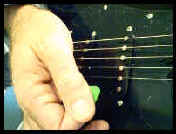
Welcome to Guitar Secrets
Guitar Lessons that work!
Guitar Picking Exercises
Guitar lesson 1 Guitar Lesson 2 Guitar Lesson 3 Guitar Lesson 4 Guitar Lesson 5
[ Sharps and flats ] [ Guitar Tablature ] [ Guitar Exercises ] [ Guitar Tuning ]
Now that you're a little more familiar with the guitar fretboard and know the strings, we can move on to some guitar picking exercises. A good idea is to get both hands working together. The picking hand has to know what the fretting hand is doing. To get these two in sync, we need to do a few exercises. When you alternate your picking hand, down and up, this helps build up speed and dexterity. One of the hardest things to learn on the guitar, is learn to properly pick each note. The next couple lessons will be some of the most challenging and important to learn and must be practiced everyday. Don't get discouraged and don't be a quitter.
For your first exercise you will be using your picking hand only. You will be starting on the Low E string. Remember to alternate the guitar pick down and then up. I personally use a pick, but some musicians choose not to. However, there are some songs that I use my fingers to pick. Eventually you will develop your own style. Some guitars may not have a pick guard, maybe a classical guitar, so be careful with the pick if you use one, but you really shouldn't use one on a classical.
Once you become comfortable with these guitar picking exercises, start from the High E = thinnest string and work your way back up. Don't worry about fretting the guitar strings, this exercise is just for the picking hand. By the way, when I say fretting the guitar, I'm referring to pushing the note down on to the fretboard.
If you would like to fret notes, go for it. In our next guitar lesson, we will use the picking exercises to build up the fretting hand dexterity and speed.
Once again, when you're fretting a note, you are actually pushing down on the string on the fretboard and are playing a particular note. When you play an open note, you are picking the open string, and not actually pushing down on the fretboard.
The illustration below shows how I hold the guitar pick. It takes time to get use to holding the pick, but in time it will become more comfortable.
If you need to learn how to read tablature, you can go to that lesson first.
The letters below, represent the picking motion, d equals pick down and u equals pick up. Each letter is placed on the particular guitar string you pick. Start on the Low E string which in the illustration below, then move to the A string next.
You will be picking each string open and only once on the first exercise. Start by picking the Low E string down. Then move to A string and pick up and so on....... The guitar tablature has also been included. The 0's on the line mean that you play that string open, you don't fret it. When you hear something like, you don't fret it, that means you don't push the note down, you pick the sting open.
Now you will be picking each guitar string 2 times, each time you will alternate the picking motion down then up. Once again, you will start with the Low E string or thickest string. Pick the Low E string down, then up.
Now you will pick each string 3 times. Remember to always alternate the pick.
Now you will pick each string 4 times.
Assignment:
-
Practice each guitar picking exercise as much as possible. Remember to alternate the pick.
-
Review the guitar fretboard chapter each day or until you have it memorized.
-
If you're up to it, check out the guitar finger exercises at that particular chapter.
- Basic Guitar Chords
-
If you're really up to it, pick the Am pentatonic scale, root note fret but not required yet.
- Have any questions, drop us a line
In our last guitar lesson, you were asked to fill in the notes of the Low and High E Strings. Your illustration should look something like the one below. Notice that both E strings have the same notes, located at the same frets. Also notice how each note repeats after 12 frets. All guitar notes repeat after 12 frets on every string. So the fretboard is identical after the 12 frets as to the first 12 frets.
In our last guitar lesson, you were also asked to tune your guitar. It's a good idea to always tune your guitar while increasing the tension. Tuning the guitar is not an easy task and it will take sometime to learn. Don't let this discourage you. Every step along the way will need time to learn. Each day you should practice something new. Always go back to the previous guitar lessons and you will notice how much you've actually learned. I believe everyone should own a guitar tuner. They work great for both acoustic and electric guitar.
Good luck,
Guitar Secrets











